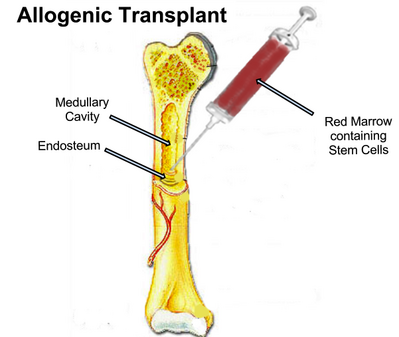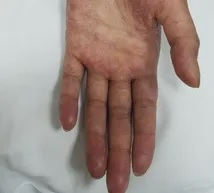Chronic Graft Versus Host Disease
Introduction[edit | edit source]
Graft versus host disease (GvHD) is a very common complication of bone marrow transplantations ( also known as allogeneic haematopoietic stem cell transplantation). Anti-rejection drugs have decreased the incidence, however it still occurs regularly.[1]
Etiology[edit | edit source]
In the following situations GvHD occurs:
- After allogeneic bone transplantation, most common.
- Post transplantation of solid organs rich in lymphoid cells such as the liver.
- After transfusion of un-irradiated blood.[2]
Graft versus host disease presents either early/acute (<100 days) or late/chronic (>100 days) post-allogeneic haematopoietic stem cell transplantation, being a major complication. The skin, gastrointestinal tract (in particular the small bowel), and liver are the organs most often affected.[1]
How is GVHD Diagnosed?[edit | edit source]
A clinical diagnosis is usually made. Typically diagnosis includes the following:
- Immunologically competent cells present in the graft.
- The recipient has transplantation alloantigens appearing foreign to the graft and hence stimulate it antigenically.
- The recipient cannot mount an effective immunologic reaction against the graft, or enough time is allowed for the graft to manifest an immune response.[2]
What Are the Clinical Manifestations for cGVHD?[edit | edit source]
Acute GVHD typically involves the skin, gastrointestinal tract, and liver. It may involve the lungs, kidneys, eyes, and hematopoietic system. Decreased responsiveness to active immunization may also occur.
Skin manifestation commonly arise as pruritic or painful maculopapular rash, first involving the palms, soles shoulders, and nape of the neck.
GI symptoms usually include diarrhea and abdominal pain, but mucositis, mucosal ulceration, nausea, and vomiting. Liver involvement usually include abnormal liver function tests with elevated bilirubin and alkaline phosphatase levels.
Chronic GVHD has a presentation similar to collagen vascular disorders and systemic sclerosis.
Death may occur due to recurrent infections (as a complication of immunosuppression).[2]
References[edit | edit source]
- Filipovich AH, Weisdorf D, Pavletic S, Socie G, Wingard JR, Lee SJ, Martin P, Chien J, Przepiorka D, Couriel D, Cowen EW. National Institutes of Health consensus development project on criteria for clinical trials in chronic graft-versus-host disease: I. Diagnosis and staging working group report. Biology of blood and marrow transplantation. 2005 Dec 31;11(12):945-56.
- Baudard M, Vincent A, Moreau P, Kergueris MF, Harousseau JL, Milpied N. Mycophenolate mofetil for the treatment of acute and chronic GVHD is effective and well tolerated but induces a high risk of infectious complications: a series of 21 BM or PBSC transplant patients. Bone marrow transplantation. 2002 Sep 1;30(5):287.
- Filipovich AH, et al. National Institutes of Health consensus development project on criteria for clinical trials in chronic graft-versus-host disease: I. Diagnosis and staging working group report. Biol Blood Marrow Transplant. 2005;11:945-956.
- Janin A, et al. Fasciitis in chronic graft-versus-host disease: a clinicopathologic study of 14 cases. Ann Intern Med. 1994;120:993-998.
- Couriel DR, et al. Chronic graft-versus-host disease manifesting as polymyositis: an uncommon presentation. Bone Marrow Transplant. 2002;30:543-546.
- Haruki H, et al. Neuropathy in chronic graft-versus-host disease caused by donor T cells. Muscle Nerve. 2012;46:610-611. 39.
- Rennie JA, Auchterlonie IA. Rheumatological manifestations of the leukaemias and graft versus host disease. Baillière’s Clinical Rheumatol. 1991;5:231-251.
- Chiodi S, Spinelli S, Ravera G, Petti AR, Van Lint MT, Lamparelli T, Gualandi F, Occhini D, Mordini N, Berisso G, Bregante S. Quality of life in 244 recipients of allogeneic bone marrow transplantation. British journal of haematology. 2000 Sep 1;110(3):614-9.
- Pallua S, Giesinger J, Oberguggenberger A, Kemmler G, Nachbaur D, Clausen J, Kopp M, Sperner-Unterweger B, Holzner B. Impact of GvHD on quality of life in long-term survivors of haematopoietic transplantation. Bone marrow transplantation. 2010 Oct 1;45(10):1534-9.
- Wong FL, Francisco L, Togawa K, Kim H, Bosworth A, Atencio L, Hanby C, Grant M, Kandeel F, Forman SJ, Bhatia S. Longitudinal trajectory of sexual functioning after hematopoietic cell transplantation: impact of chronic graft vs. host disease and total body irradiation. Blood. 2013 Jan 1:blood-2013.
- Thygesen KH, Schjødt I, Jarden M. The impact of hematopoietic stem cell transplantation on sexuality: a systematic review of the literature. Bone marrow transplantation. 2012 May 1;47(5):716-24.
- Kirchhoff AC, Leisenring W, Syrjala KL. Prospective predictors of return to work in the 5 years after hematopoietic cell transplantation. Journal of Cancer Survivorship. 2010 Mar 1;4(1):33-44.
- Martires KJ, Baird K, Steinberg SM, Grkovic L, Joe GO, Williams KM, Mitchell SA, Datiles M, Hakim FT, Pavletic SZ, Cowen EW. Sclerotic-type chronic GVHD of the skin: clinical risk factors, laboratory markers, and burden of disease. Blood. 2011 Oct 13;118(15):4250-7.
- Markusse HM, Dijkmans BA, Fibbe WE. Eosinophilic fasciitis after allogeneic bone marrow transplantation. The Journal of rheumatology. 1990 May;17(5):692-4.
- Deitrick JE, Whedon GD, Shorr E. Effects of immobilization upon various metabolic and physiologic functions of normal men. Am J Med. 1948;4:3-36.
- Cuccurullo S. Physical medicine and rehabilitation board review, 2nd ed. New York: Demos; 2010. 53.
- Gupta A, Gupta Y. Glucocorticoid-induced myopathy: pathophysiology, diagnosis, and treatment. Indian J Endocrinol Metab. 2013;17:913.
- Stevens AM, Sullivan KM, Nelson JL. Polymyositis as a manifestation of chronic graft-versus-host disease. Rheumatology. 2003;42:34-39.
- Sullivan KM, et al. Chronic graft-versus-host disease in 52 patients: adverse natural course and successful treatment with combination immunosuppression. Blood. 1981;57:267-276.
- McClune BL, et al. Screening, prevention and management of osteoporosis and bone loss in adult and pediatric hematopoietic cell transplant recipients. Bone Marrow Transplant. 2011;46:1-9. 49.
- Schimmer AD, et al. Decreased bone mineral density is common after autologous blood or marrow transplantation. Bone Marrow Transplant. 2001;28:387-391. 50.
- McClune B, Majhail NS, Flowers ME. Bone loss and avascular necrosis of bone after hematopoietic cell transplantation. Semin Hematol. 2012;49: 59-65.
- Enright H, Haake R, Weisdorf D. Avascular necrosis of bone: a common serious complication of allogeneic bone marrow transplantation. Am J Med. 1990;89:733-738. 55.
- McAvoy S, et al. Corticosteroid dose as a risk factor for avascular necrosis of the bone after hematopoietic cell transplantation. Biol Blood Marrow Transplant. 2010;161231-161236.
- Sean Robinson Smith, Andrew J. Haig, Daniel R. Couriel, Musculoskeletal, Neurologic, and Cardiopulmonary Aspects of Physical Rehabilitatin Patients with Chronic Graft-versus-Host Disease, Biology of Blood and Marrow Transplantation, Volume 21, Issue 5, May 2015, Pages 799-808, ISSN 1083-8791, https://doi.org/10.1016/j.bbmt.2014.10.019.
- ↑ 1.0 1.1 Radiopedia Graft versus host disease Available: https://radiopaedia.org/articles/graft-versus-host-disease(accessed 28.1.2023)
- ↑ 2.0 2.1 2.2 Vaillant AA, Modi P, Mohammadi O. Graft versus host disease. InStatPearls [Internet] 2022 Jul 8. StatPearls Publishing.Available:https://www.ncbi.nlm.nih.gov/books/NBK538235/ (accessed 28.1.2023)








